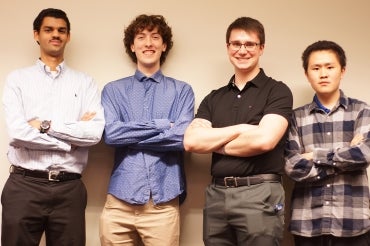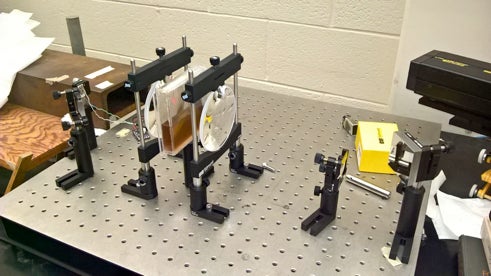U of T student team selected to compete in microgravity experiment challenge

Team FAM includes engineering science students (from left): Twesh Upadhyaya, Tyler Gamvrelis, Jacob Weber and Hanzhen Lin. (photo courtesy of Team FAM)
Published: May 29, 2018
A team of students from the University of Toronto’s Faculty of Applied Science & Engineering is set to launch an experiment aboard the National Research Council of Canada’s Falcon 20 jet, part of the Canadian Reduced Gravity Experiment Design Challenge (CAN-RGX).
Team FAM (Fluids Affected by Magnetism) is one of just four post-secondary teams selected for this year’s challenge, joining a team from the University of Calgary and two teams from Queen’s University. The teams will fly various experiments in microgravity during the flight campaign, which will take place over three days in Ottawa at the end of July.
“What really struck me was the opportunity to not only fly in microgravity but to conduct an experiment in microgravity and really see the progress from start to finish – from the proposal to conducting the experiment on a very unique testbed,” said Twesh Upadhyaya, a third-year engineering student who is one of two primary mission specialists for Team FAM who will fly onboard the Falcon 20.
“This year’s CAN-RGX is a unique opportunity for us to put into practice all of the engineering design knowledge we’ve gained so far.”
The competition challenges post-secondary student teams from across the country to design and build an experiment to be flown on board the NRC’s Falcon 20 – an aircraft modified for parabolic flight to simulate microgravity – in collaboration with the Canadian Space Agency. This is the second year a team from U of T Engineering was selected for the competition.
Team FAM’s experiment will examine heat transfer in paramagnetic fluids and their behaviour under external magnetic fields. To carry out the experiment, the team developed a compact optical setup that enables them to “see” the temperature of the fluid. A fluid cell holds the paramagnetic fluid, and a set of two electromagnetic coils is positioned around it.

Team FAM’s prototype, which will be used to investigate the effectiveness of heat transfer mechanisms of a paramagnetic fluid in microgravity (photo courtesy of Team FAM)
The team’s literature review suggests nobody has ever visualized the heat distribution in a paramagnetic fluid under microgravity conditions before.
“We have a system that will – at the peak of the flight when we hit zero gravity – automatically trigger the experiment to start,” says Upadhyaya. “We’ll do one parabola, gather the data, and repeat the experiment with different parameters. The plan is to do eight to 10 parabolas.”
The team’s goal is to gain a better understanding of how paramagnetic fluids behave in zero gravity, which could lead to improved heat management in spacecraft, space stations and satellites. They also hope to gain a better understanding of the fundamental behaviour of magnetic fluids in microgravity.
Topics
Engineering



